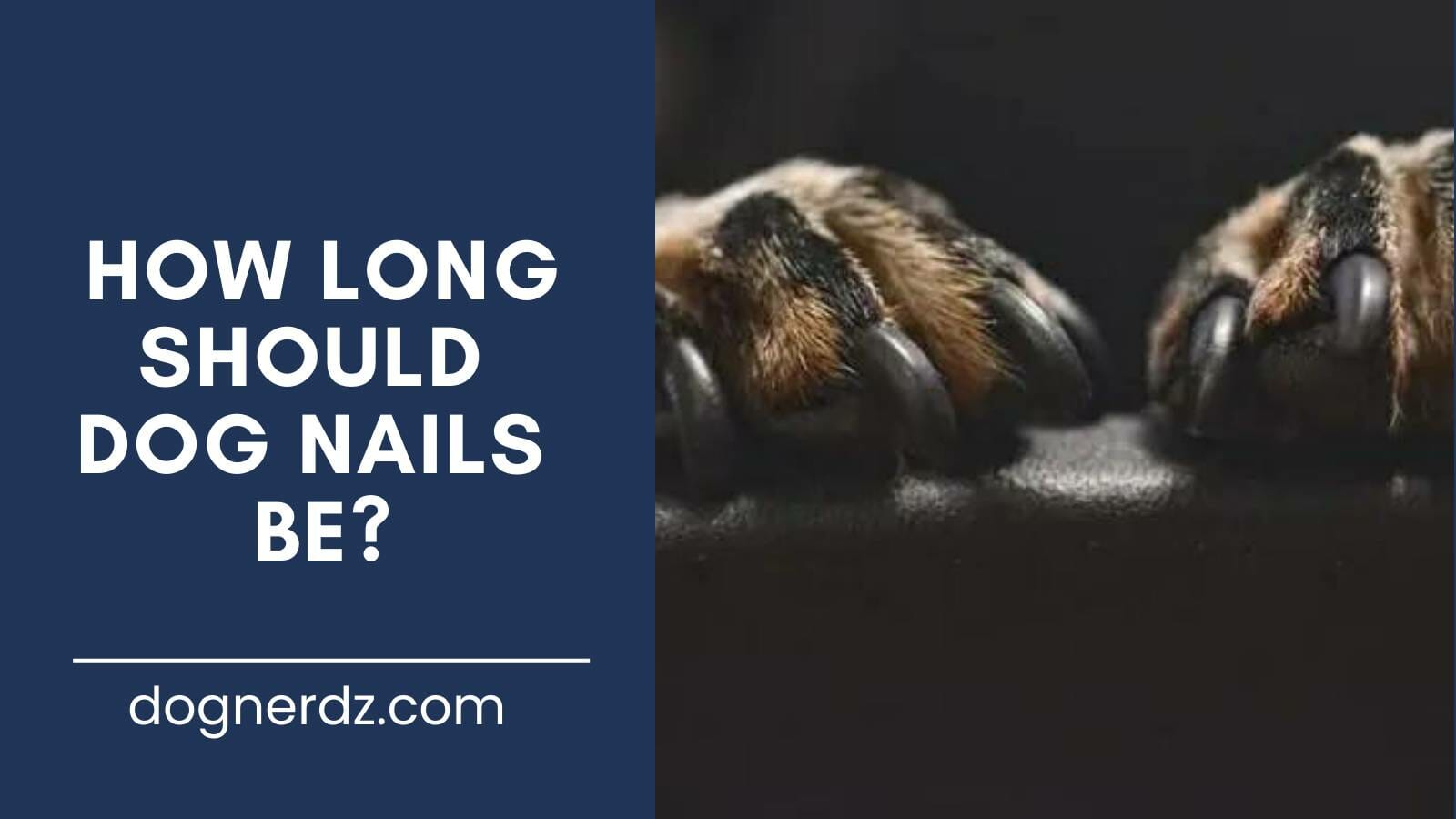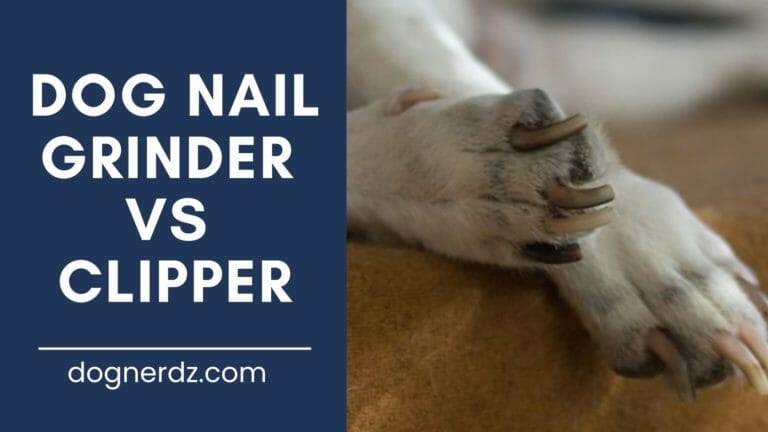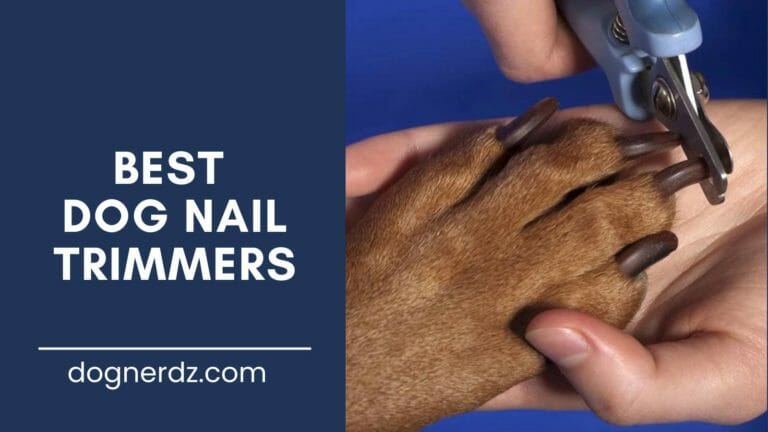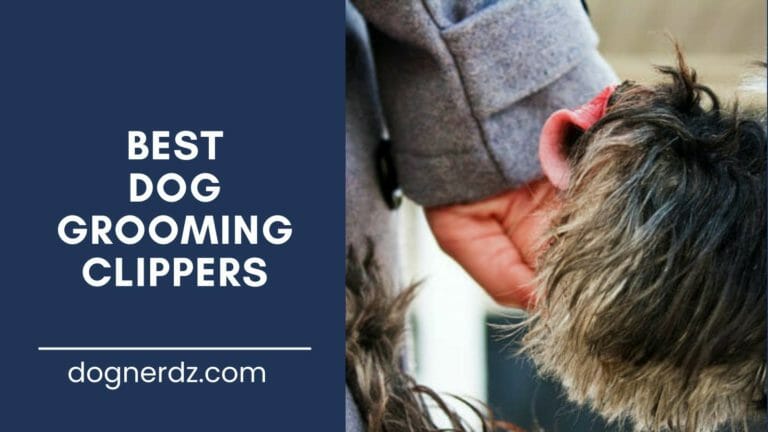How Long Should Dog Nails Be?
Just like you enjoy a good nail trim, so does your pup, but let’s be real, their spa day looks a tad different. No fancy nail polish or gel art for them – it’s all about a basic clip and perhaps a quick grind.
Many dog owners underestimate the importance of trimming their dog’s nails.
Excessively long dog nails can actually get in the way of daily activities such as walking.
Today, we’re going to explore how long your dog’s nails should be.
Table of Contents
When is It Too Long?
The answer is simple. If you can hear your dog’s nails go clickety-clack against the tiles, then you know it’s time for a trim. You can also take a look at your dog’s nails.
Are they protruding far over his foot pads?
Do they touch the ground when he’s standing?
If so, then it’s time to break out the nail clippers.
But you shouldn’t cut them too short either, because your dog relies on the nails for traction and grip when he works his way through various terrains.
What are the Different Parts of Dog Nails?

Before we get into how to clip the nails, let’s take a look at the science behind the nails and the different parts.
If your dog has clear nails, then you will have a view of a pink portion embedded inside the outer nail. The pink part is a congregation of living tissue and blood vessels referred to as “the quick”.
It’s similar to our fingers, where if we were cut too close to the nail bed, we’d feel pain.
This is the same for dogs but evidence shows the pain is more severe and the bleeding is much more serious. This is why if you decide on cutting your dog’s nails at home, you need to be very careful not to injure the quick.
How long should dog nails be? We would recommend a few millimeters of space, around about 3, to ensure you don’t hurt your dog.
However, it can be hard to gauge the exact measurement, especially if your pooch is squirming and crying.
There is something very interesting about the quick. The longer you allow the nails to get, the longer the quick grows too.
However, the quick is almost alive as it will recede if you always trim before the nails are too long.
Why is My Dog Scared of Getting His Nails Cut?

How many pet owners go into battle with their dogs come nail trimming time? The mere sight of dog nail clippers sends your dog running in the other direction. If this sounds like you, we’re pretty sure you’d want to know why.
Dogs are afraid of trimming their long nails because they associate the pressure of the nail clippers coming down with potential pain. Their toes are sensitive areas and since you are cutting so close to the quick, your dog fears impending pain – even if it never comes.
The only way out of this sometimes for some unfortunate pet parents is mild anesthesia at the vet’s office.
Before we get to that stage and take drastic measures, let’s try some other methods to calm your dog down during nail cutting.
How to Calm My Dog Down During Nail Trimming

There is nothing worse than a squirming dog fighting to get away with long nails that touch the ground. You will experience a lot of scratches and maybe even bleed from the destruction of a scared pup. Sure, you can turn to restraints, but let’s try something gentler first.
A very good way to keep dogs distracted while you rim their nails is to use a treat. They may be too focused on what snacks are on the ground to realize you’re slowly cutting their digits one by one.
Ideally, you want to keep your pup still during the process, so enlisting the help of a friend or family member to hold onto them when you cut your dog’s nails is best. However, even if you can’t, there is still a way.
You can try to put the harness on your dog and keep him tied to a stationary object with a short leash. This will greatly limit his range of movement without making him feel like he’s tied down and elicit further resistance. There are also dog nail cutting accessories such as a toy that sticks to the wall to keep your dog stationary without any restraints as he focuses on the treat.
If you don’t have something like that, you can use a dog toy such as a Kong that has a hollow center to allow for treat stuffing. We found that peanut butter is an excellent treat that is very appealing to dogs but won’t pack on the calories. You can try smearing some peanut butter inside the toy and let your dog go at it.
If it takes extra long for you to trim your dog’s nails, then there is a way to make the peanut butter last even longer. Try to mix the paste in with a bit of water and freeze it in the toy overnight. The next day, it will lengthen the time it takes for your dog to get through it and free up more time for you to trim your dog’s nails.
If you have a small dog, dog cookies could be enough. Their smaller mouths and smaller teeth will have a harder time getting through tough cookies.
Importance of Cutting Your Dog’s Nails
Why can’t we just leave the trimming to the professionals once a year or come grooming time? You can if your dog’s nails grow slowly, but from experience, dogs will need a nail trim anywhere from 1 week to a month.
You want the quick to be as short as possible to cut down the frequency of cutting your dog’s nails. To do this, it requires regular cutting in order for the quick to recede.
If you leave your dog’s nails unattended for long periods, it could end up causing health issues such as a splayed foot, injure your dog’s tendons, and could cause muscle development issues.
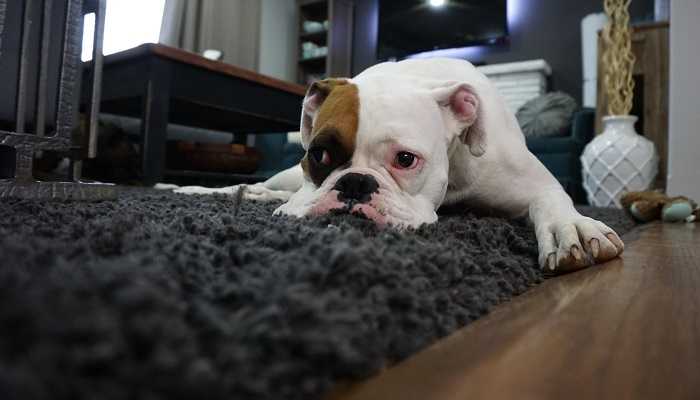
What to Tool to Use for Nail Trimming
There are different tools you can use for nail trimming. There are the regular dog nail clippers that look like a hybrid between scissors and pliers, and then there are nail grinders.
Let’s take a look at each in more detail to help you pick the right type. What works for your dog may not work for another and sometimes it will take some trial and error to find the right tool.
Related: Dog Nail Grinder vs Clipper: Which Is Better For Trimming Dog Nails?
Nail Clippers
Regular dog nail clippers can be split into two different types: guillotine nail clippers and scissor clippers.
A guillotine nail clipper functions much like the name suggests. You place your dog’s nails inside a little hole and press down on the handle. Then a blade will come down guillotine-style and cut off the excess.
A scissor clipper works like scissors and is applied in the same way. You would place your dog’s nails in between the blades and cut down from both sides the way you would scissors.

Nail grinders, on the other hand, are completely different. For dog owners who frequent nail salons for acrylics, you may have seen something similar your nail beautician uses to thin your natural nails.
The grinders have a small rotating attachment that has a tough surface similar to sandpaper. You use nail grinders by slowly applying them to your dog’s nails and slowly wearing them down.
Dog Nail Clipper Pros
One major edge nail clippers have over grinders is their quiet operation. Sometimes it’s merely the sound that can send your dog running, and nail clippers are more unassuming.
Dog nail clippers are also cheaper and don’t need constant replacement of the grinder heads. In the long run, dog nail grinders can really run up the price.
You can also use nail trimmer anywhere you go and they are easy to take with you as they fit into your pocket.
We wrote a detailed article looking into the best dog nail trimmers on the market, give it a read to learn more.
Dog Nail Clipper Cons
Nail clippers don’t have a gradual application, so it’s much easier for inexperienced dog owners to make a mistake when cutting nails. Most accidents involving cutting quicks involve dog nail clippers.
The squeezing pressure caused by the application is also a culprit for your dog’s fear. There is also more of a chance of breakage and the results from clipping are very rough so your dog’s newly cut nails are extra sharp and can hurt if he scratches you.
Dog Nail Grinder Pros
A dog nail grinder is often what vets recommend for a dog that fears the clippers. The results are also infinitely smoother than what the clippers produce and won’t hurt you after a fresh cut.
If you have a large breed, then you’ll know it takes some force to bring down the blades, which will make the aftermath of cutting the quick even worse and more painful. With a nail grinder, your margin of error is significantly less.
Dog Nail Grinder Cons
Since a dog nail grinder requires electricity to operate, you are limited to using it near a power source. There are also more components to keep track of, they are more expensive and require regular maintenance.
The noise is also an issue. The grinding sound might become a trigger for your dog and become the cue to make a run for it.
One last issue with dog nail grinders you have to be ready for is the dust and the mess. You will need to wear a face mask to avoid breathing in the nail powder.
Related: 5 Best Nail Grinders for Dogs
How to Cut Your Dog’s Nails
In order to be successful, you need to exert a sense of authority over your dog when it’s trimming time.
Once your dog has become familiarized with the tool, you can start to trim.
The process should take about 3 days to a week of letting your pooch sniff and inspect the tool before finally using it.
Cutting
For cutting, grip each toe firmly but gently between your thumb and forefinger and press down softly. This will cause your dog’s nails to protrude further for a clearer view. You should also make it a habit to trim your dog’s fur covering the nails so your view isn’t obstructed.
For clear nails, where the shell ends and the quick starts should be very obvious. Measure about 2-3 mm from the end and make your cut. Don’t forget the dew claws, which are the little extra claw near your dog’s ankle.
Many experts also suggest bending your dog’s claws backward and cutting that way as it will conform to the curve of the nail better.
Grinding
Grinding is a lot easier and requires less attention to precision but you should still be careful. Grip your dog’s toes the way you would if you were using a trimmer and grind across the shell in a slow back and forth motion.
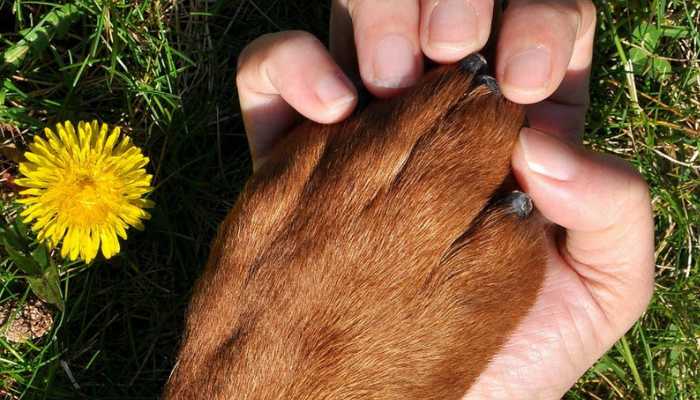
It’s more important to keep the fur short on your dog’s toes as they can get caught in the grinder. The application is slow, so don’t rush it, and don’t forget the dew claw.
What About Dark Nails?
It’s all pretty simple if you can see where the nail ends and the quick starts, but some dog owners aren’t so lucky and have dogs with black nails.
You will need to trim dark nails in a place with ample lighting. Maybe even consider holding a flashlight directly over the nail.
Our best advice for cutting dark nails is to do it slowly little by little. You will need to examine the nail after each cut. You are looking for a subtle dark spot that should present itself in the center of the nail as you cut slowly. That black spot is the beginning of the quick so when you see it, it’s time to stop.
If you want to reduce the risk of an accident, you can always turn to your trusted groomer or vet who can do the job more accurately.
What if You Cut the Quick?
Many trainers may make it seem like cutting the quick is the end of the world. We won’t debate the fact that cutting the quick will significantly hinder future efforts and set you back.
You will need to slowly gain your dog’s trust again and get him reacquainted with the clipper or grinder. However, it can be done with patience.
Just in case you cut the quick, it’s always a good idea to have paper towels and coagulants handy to treat the injury. Styptic powder and pads are excellent blood clotters that can stop the blood flow quickly, but if you’re in a pinch, corn starch will do as well.
Dogs tend to lick their wounds, hence the phrase, so in order to allow the injury to heal quickly, we would enlist the help of a donut or cone.
There is One More Way
Let us present the dog nail filer. It has a surface similar to the nail files we use but in a much larger form. The dog nail filer is essentially a scratching board for dogs. While your dog scratches or digs at the surface profusely, it will carry out the same functions as a nail grinder. It also requires replacement components such as the nail grinder, but it can last a good while.
We would say the downsides of this nail filing board are the even application to all of your dog’s nails and the training process.
It is less likely that your dog will be able to get all his nails down to the same length, which will require some trimming on your part anyway, especially with the dew claw.
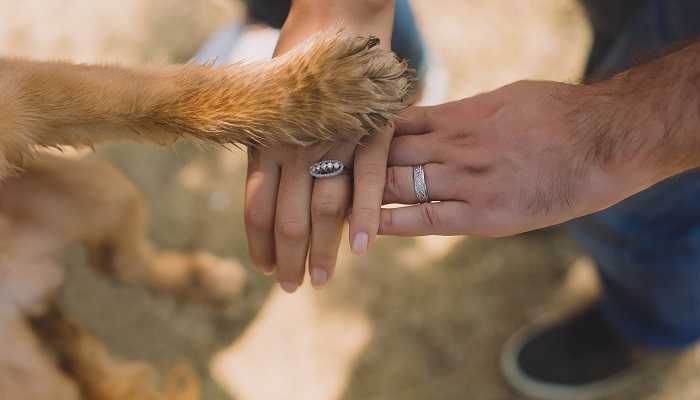
When you first receive the nail filer board, your dog won’t understand what to do with it. It will require some training and lots of treats and encouragement to get him to understand. Start by guiding your dog’s paw on the board with your own hand and giving him a treat each time.
Each time you embark on a training session your dog should start to associate the repeated movement with rewards. Slowly he will learn to do it himself and with enough speed to trim his nails.
Frequently Asked Questions
Can long nails hurt my dog?
It depends on the length, but dog nails that are too long can hurt your dog and even lead to developmental issues such as a splayed foot. If your dog’s nails are too long, they can become uncomfortable and in more serious cases lead to injury. It will also result in reduced paw traction and make it more difficult for your dog to engage in regular activities.
Our experts recommend cutting your dog’s nails every 1-2 weeks for regular maintenance.
Should dogs have long nails?
If you regularly keep your dog’s nails at quick length, it can also create some problems. Your pup will have a harder time gripping dirt and climbing hills. On the other hand, if the nails are too long, it could pose other issues such as increased chances of injuries. Your best bet is to find a balance, which would be about 3-5 mm from the quick.
Will my dog be OK if I cut his nails too short?
You don’t want to knick the quick when you are cutting your dog’s nails. Similar to our nail bed, the quick can bleed if you cut it and the main is quite severe As long as you leave room for the quick, it’s okay to cut your dog’s nails a few mm away from it. Your pet will be okay if his quick is unharmed.
How long does it take for a dog’s nail quick to heal?

If you accidentally cut the quick, you may be wondering how long it will take before it fully heals. Depending on the severity of the cut, it could take anywhere from 3 days to a week. The bleeding should subside quickly, within 5 minutes, but you will need to properly bandage the wound for healing.
During the recovery period, it’s important to not let your pooch lick the injury. The saliva will prolong the healing and could even cause infection. The best way to keep your pet away from his toes is to use a cone or donut.
How do you restrain a pup to cut his nails?
We mentioned that restraints are a way to keep your pooch still, but they should be used as a last resort as you don’t want dogs to feel threatened. For small dogs, you can use a blanket and swaddle them tightly leaving only the foot in question out in the open.
Unfortunately, larger dogs are harder to control and may need a nail trimming harness, and some of these come with the entire nail trimming table.
You can also opt to hold your dog in such a way that it cannot get away. Sometimes it’s easier to have two people working together, one holding the dog and the other cutting the nails.
Conclusion
Restrains and the highway are the last resorts. There are plenty of options to keep your dog’s nails at optimal lengths such as clippers, grinders, and a nail file board.
Whatever you choose, you should be careful and go at it slowly. You have to be extra careful if your fur baby has black nails, and always remember to reward your pooch when the job is done with a treat and a pat.
Did You Know?
You can soften the nails with warm water or oil to make the nail easier to cut. This is a handy tip for dogs with very hard nails that can result in a lot of splinters.
Expert Tip
Walking on asphalt or concrete regularly is another method to keep your dog’s nails at a good length. The ground functions like the nail filing board and it’s easy to do since most of us live in cities with paved streets.

